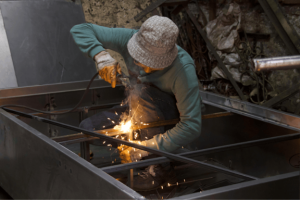Last Updated on October 30, 2025 by teamobn
When building a home, the choice of framing materials plays a critical role in shaping the project’s overall success, not just structurally but also financially. Framing is the backbone of any house, dictating how it will withstand environmental stresses, adapt to future modifications, and ultimately retain its value over time. For homeowners and owner-builders, deciding between timber and steel framing can be one of the most significant decisions in the construction process.
Both timber and steel framing offer distinct advantages, but their suitability depends on factors that go far beyond surface-level costs or aesthetic appeal. For instance, timber has been a trusted material for centuries, prized for its natural warmth and ease of use. On the other hand, steel framing, often seen as a modern alternative, boasts remarkable resilience and consistency.
These two materials also differ widely in how they perform under stress—whether that’s exposure to moisture, changes in temperature, or pest invasions.
Your framing material choice also impacts the entire lifecycle of your home, influencing maintenance needs, long-term expenses, and even how well the home supports sustainable construction practices.
This decision is not merely a matter of budget but a question of aligning priorities, from durability and environmental impact to ease of installation and the future-proofing of your investment.
Understanding the nuanced strengths and weaknesses of both options is essential for making an informed choice that balances immediate affordability with long-term value.
Contents
Comparing Key Factors: Timber vs. Steel House Frames and Trusses
Choosing between timber and steel framing requires a detailed look at how each material performs in key areas that influence the durability, maintenance, and long-term value of your home. While both options have their strengths, understanding these critical factors will help you make an informed decision that aligns with your priorities and budget.
Durability and Longevity
Timber framing has a natural resilience, particularly when treated against decay and pests. However, it is susceptible to warping, shrinking, and swelling due to changes in humidity and temperature. Over time, this movement can lead to cracks in finishes or structural instability if not properly managed. Steel, on the other hand, offers unparalleled dimensional stability. It does not warp, shrink, or swell, maintaining its shape and integrity for decades.
Pest Resistance
One of timber’s major vulnerabilities is its susceptibility to termites, borers, and other wood-damaging pests. While chemical treatments can mitigate this risk, they add to the maintenance requirements and costs. Steel framing is inherently pest-proof, providing peace of mind in regions prone to infestations without the need for additional protective measures.
Resistance to Environmental Stressors
- Timber:
- Absorbs and releases moisture, which can cause expansion and contraction.
- Can weaken in areas of persistent high humidity or water exposure.
- Steel:
- Immune to moisture absorption, maintaining stability in humid environments.
- Highly resistant to extreme weather conditions, including fire, when properly treated.
Maintenance Requirements
Timber-framed homes typically require more attention over time. Regular inspections and treatments are needed to prevent pest damage and address any warping or moisture-related issues. Steel, being resistant to pests and environmental changes, demands minimal maintenance, making it a low-effort option for long-term homeowners.
Side-by-Side Comparison
- Timber:
- Natural and aesthetically pleasing.
- Easier to work with during construction.
- Requires ongoing maintenance and treatments.
- Steel:
- Highly durable and resistant to pests and environmental changes.
- Requires specialized tools and expertise for construction.
- Higher upfront costs but lower long-term maintenance expenses.
Advantages and Disadvantages at a Glance
Timber Framing:
- Advantages:
- Cost-effective upfront.
- Flexible and easy to modify during construction.
- Renewable resource, especially when sourced sustainably.
- Lower thermal conductivity.
- Disadvantages:
- Vulnerable to pests and environmental conditions.
- Requires regular maintenance and treatments.
- Prone to warping and shrinking.
Steel Framing:
- Advantages:
- Exceptional durability and stability.
- Pest and moisture resistant.
- Minimal maintenance requirements.
- Disadvantages:
- Higher initial costs.
- Requires specialized construction techniques.
- Non-renewable, though recyclable.
- Higher thermal conductivity
By examining these critical factors, you can better weigh the trade-offs between timber and steel framing. Whether you prioritize upfront savings, ease of maintenance, or long-term resilience, your framing choice will significantly shape the future of your home.
Cost Considerations: Upfront and Long-Term
When evaluating timber and steel framing, cost is often a decisive factor for homeowners. However, the financial implications of your choice extend beyond the initial expense, influencing the long-term value, maintenance requirements, and overall affordability of your home.
Initial Construction Costs
Timber framing is generally more affordable upfront, as the material is widely available and easy to work with, reducing both material and labor costs. Timber’s versatility allows for efficient on-site modifications, further minimizing construction delays and associated expenses.
Steel framing, while more expensive initially, comes with its own set of efficiencies. Precision-engineered steel components often arrive pre-fabricated, reducing waste and installation time. However, the need for specialized tools and expertise during construction can add to labor costs.
As one seasoned builder aptly puts it, “You pay for steel upfront, but you save on headaches down the road.” This sentiment highlights how the true cost of framing extends beyond the price tag of materials alone.
Maintenance Costs
Timber’s affordability can be offset by ongoing maintenance expenses. Regular inspections, pest treatments, and the potential need for repairs due to warping or moisture damage all add to the lifetime cost of timber-framed homes. These maintenance needs are particularly significant in areas prone to termites, high humidity, or extreme weather conditions.
Steel, on the other hand, requires minimal maintenance. Its resistance to pests, moisture, and fire means homeowners rarely need to worry about structural issues. This low-maintenance nature makes steel a cost-effective option in the long term, particularly in challenging environments.
Thermal Conductivity
Steel frames have a higher thermal conductivity than timber, which can lead to poor insulation properties if not adequately addressed during construction. With appropriate insulation, the potential differences between steel and timber framing and trusses can be minimal. Another factor in steel framing’s favour is that the very precise assembly of steel frames ensures a tighter fit for doors and windows, leading to improved sealing and reduced heat loss at the joints.
Lifetime Value and Resale
Steel’s durability and stability contribute to its long-term value, making it a smart investment for those planning to stay in their homes for decades or for resale purposes. Homes with steel framing often appeal to buyers seeking low-maintenance properties, which can enhance resale potential.
Timber, while requiring more upkeep, remains attractive for its natural aesthetic and sustainability. For buyers prioritizing environmental considerations, sustainably sourced timber framing can be a compelling feature.
Balancing Short-Term and Long-Term Costs
When deciding between timber and steel, it’s essential to align your choice with your priorities:
- If budget constraints are significant and you’re comfortable with ongoing maintenance, timber may be the better option.
- If you’re looking for a durable, low-maintenance solution with long-term savings, steel offers compelling value despite the higher initial expense.
Ultimately, the framing choice represents a balance between upfront affordability and long-term financial considerations. Thoughtfully assessing your goals and the specific needs of your home will ensure that your investment yields both comfort and value for years to come.
Construction and Practicality
The practicality of timber and steel framing extends beyond their material properties, impacting the ease of construction, adaptability to designs, and the overall efficiency of the building process. For homeowners and builders alike, understanding how each material performs during the construction phase is key to making an informed choice.
Ease of Installation and Construction
Timber is widely regarded as the more user-friendly option during construction. Its light weight and workability allow builders to cut, modify, and assemble components directly on-site using standard tools. This flexibility is especially valuable in custom builds, where adjustments may be needed to accommodate unique architectural features or unforeseen challenges. Additionally, timber’s familiarity within the residential construction industry means that most contractors are highly experienced in working with it, reducing the likelihood of delays or errors.
Steel, while less intuitive to work with, offers its own set of efficiencies. Prefabricated steel framing systems are precision-engineered, ensuring consistent quality and reducing material waste. These systems can accelerate the construction timeline, particularly for larger or more complex projects. However, steel requires specialized tools and skills, which can lead to higher labor costs and potential scheduling challenges if qualified contractors are not readily available.
Adaptability for Custom Designs
Timber’s natural versatility makes it a preferred choice for homes with intricate or unconventional designs. Its ability to be easily reshaped or joined provides greater freedom for architects and builders to execute unique layouts. Steel, though more rigid, is not without customization options. Prefabrication allows for precise designs, but alterations on-site can be more challenging and time-consuming compared to timber.
Sustainability and Environmental Impact
In terms of sustainability, timber stands out as a renewable resource when sourced responsibly. It has a lower carbon footprint during production compared to steel and can be harvested and replenished in a sustainable cycle. Steel, while energy-intensive to produce, is 100% recyclable and often made with a significant proportion of recycled content. For homeowners prioritizing environmental impact, both materials offer compelling sustainability credentials, though timber may have the edge for those seeking a more traditional “green” option.
Construction Efficiency: Key Takeaways
- Timber: Easy to work with, highly adaptable, and widely supported by skilled labor.
- Steel: Precision-engineered for efficiency but requires specialized tools and expertise.
Both materials bring distinct advantages to the construction process, making the choice highly dependent on your project’s complexity, timeline, and design goals. Balancing these factors ensures a smoother build and a home that aligns with your vision.
Which Framing Option is Best for Your Needs?
Choosing the right framing material for your home ultimately depends on your unique needs, priorities, and circumstances. While both timber and steel framing have their merits, the best choice comes down to factors like climate, budget, lifestyle, and long-term goals. Here’s how to determine which option aligns with your vision for your home.
Lifestyle and Climate Considerations
Your local environment plays a significant role in framing selection. If you live in an area with high humidity, frequent rainfall, or a history of termite infestations, steel framing offers a distinct advantage due to its immunity to pests and resistance to moisture. Its stability under extreme weather conditions also makes it an excellent choice for regions prone to storms or seismic activity.
On the other hand, timber may be more suitable for drier climates where pest control is less of a concern. Its natural thermal properties also make it a preferred choice in areas with cold winters, as timber provides better insulation compared to steel, which can conduct heat and cold.
Balancing Budget and Long-Term Value
For homeowners working within tight budgetary constraints, timber is often the more affordable choice upfront. Its availability and ease of construction contribute to lower material and labor costs. However, these initial savings should be weighed against ongoing maintenance expenses, especially in climates where pests and moisture pose a risk.
Steel, while more expensive initially, offers a compelling case for long-term value. Its durability and low-maintenance requirements translate to fewer repairs and less upkeep over the life of the home, which can offset the higher upfront investment. Additionally, homes with steel framing often hold their value better due to their resilience and appeal to buyers looking for low-maintenance properties.
Making an Informed Decision
To make the best choice, start by evaluating your priorities:
- If you value sustainability, natural aesthetics, and upfront affordability, timber may be the better fit.
- If you prioritize durability, low maintenance, and long-term savings, steel offers significant advantages.
Consulting with your builder or architect can also provide valuable insights, as they can assess your project’s specific needs and recommend the most suitable option. Ultimately, the right framing material will balance your current financial situation with the long-term comfort, safety, and value of your home.
Conclusion
Deciding between timber and steel framing is one of the most critical choices when building a new home. Each material brings unique strengths and challenges, making the decision highly dependent on your priorities, environment, and long-term goals.
Timber offers a traditional, cost-effective option with a natural aesthetic and excellent adaptability for custom designs. However, it requires ongoing maintenance to address vulnerabilities like warping, moisture damage, and pest infestations.
Steel, on the other hand, stands out for its unmatched durability, stability, and resistance to environmental and pest-related stressors. While its initial costs are higher and construction requires specialized skills, its low maintenance requirements and longevity make it a cost-effective solution for homeowners seeking long-term value.
The choice ultimately boils down to what matters most to you. If you’re focused on upfront affordability and a natural, eco-friendly material, responsibly sourced timber may align with your goals. If long-term durability, minimal upkeep, and resilience against environmental challenges are your priorities, steel framing could be the smarter investment.
By carefully considering factors such as climate, budget, and the future needs of your home, you can make a framing choice that ensures not only structural integrity but also peace of mind for years to come.
As a final comment, your frame and truss costs will usually be less than 20% of the total cost of building your new home. When viewed in this way, the difference in cost between steel and timber framing becomes less significant. Does that make your decision any easier?






